ME Sustainable Infrastructure: Maintenance and Best Practices
VerifiedAdded on 2023/05/28
|12
|2984
|143
Essay
AI Summary
This essay explores the critical role of good maintenance in achieving sustainable infrastructure, particularly in the context of developing cities. It emphasizes the integration of maintenance strategies into the entire lifecycle costing of infrastructure projects. The essay highlights the importance of sustainability in various sectors, including green building practices for energy efficiency and environmental protection, sustainable transportation solutions for economic development and road safety, and the shift to renewable energy sources. It also discusses the three pillars of sustainability—economic, social, and environmental—and their interconnectedness. The essay concludes that sustainability requires serious consideration and proactive measures to mitigate the negative impacts of human activities on the environment, advocating for a holistic approach to infrastructure development that prioritizes long-term maintenance and environmental stewardship.
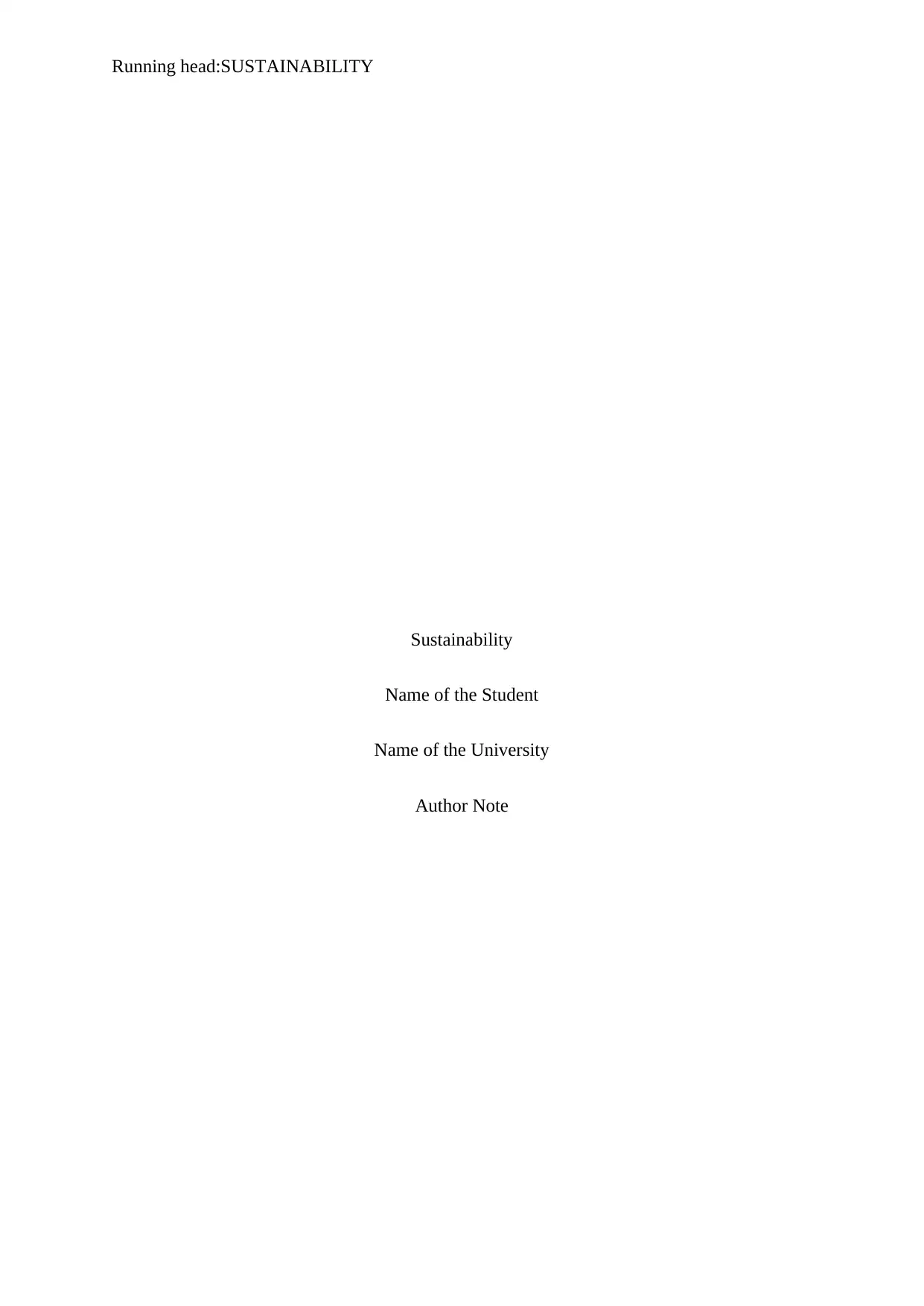
Running head:SUSTAINABILITY
Sustainability
Name of the Student
Name of the University
Author Note
Sustainability
Name of the Student
Name of the University
Author Note
Paraphrase This Document
Need a fresh take? Get an instant paraphrase of this document with our AI Paraphraser
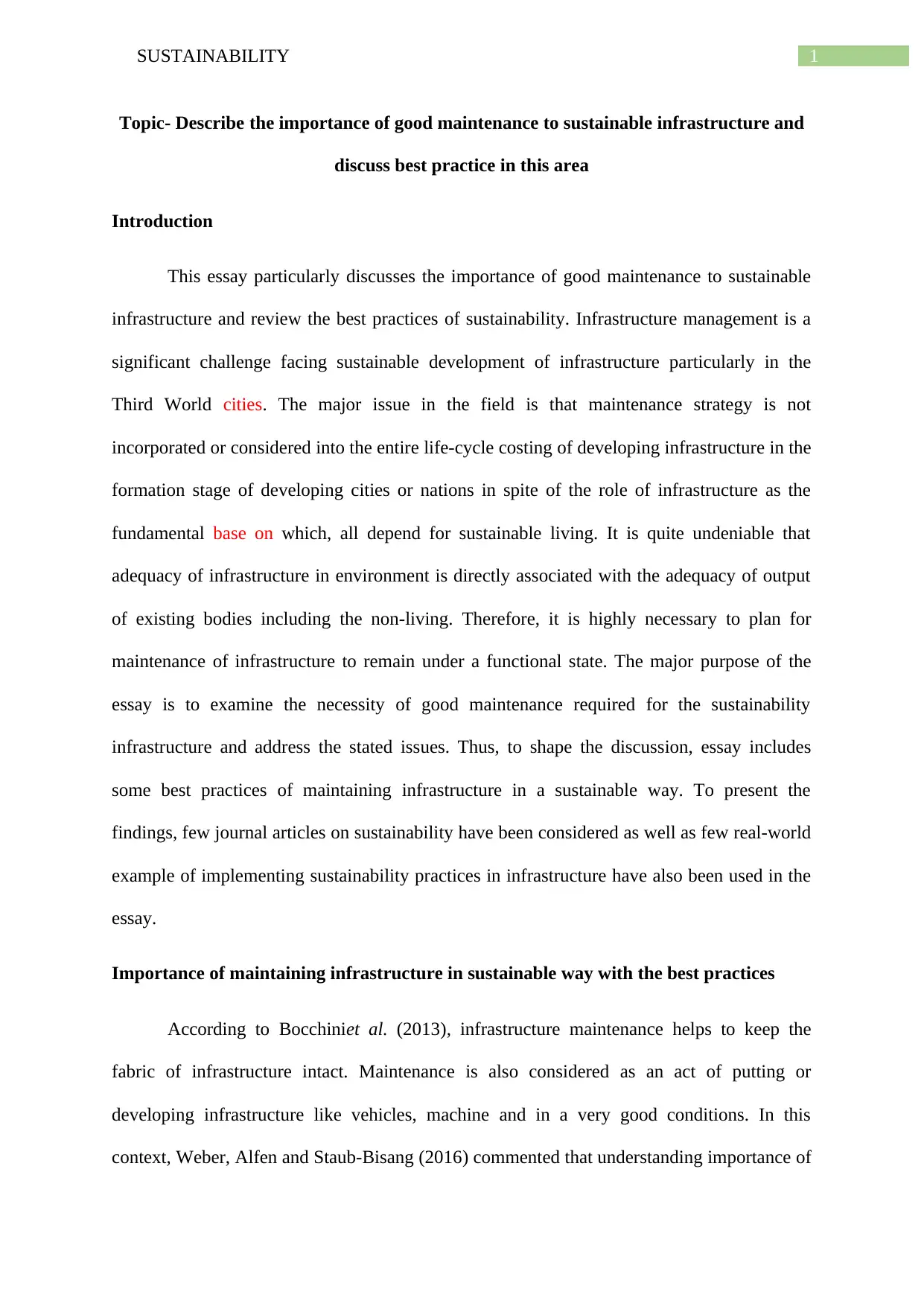
1SUSTAINABILITY
Topic- Describe the importance of good maintenance to sustainable infrastructure and
discuss best practice in this area
Introduction
This essay particularly discusses the importance of good maintenance to sustainable
infrastructure and review the best practices of sustainability. Infrastructure management is a
significant challenge facing sustainable development of infrastructure particularly in the
Third World cities. The major issue in the field is that maintenance strategy is not
incorporated or considered into the entire life-cycle costing of developing infrastructure in the
formation stage of developing cities or nations in spite of the role of infrastructure as the
fundamental base on which, all depend for sustainable living. It is quite undeniable that
adequacy of infrastructure in environment is directly associated with the adequacy of output
of existing bodies including the non-living. Therefore, it is highly necessary to plan for
maintenance of infrastructure to remain under a functional state. The major purpose of the
essay is to examine the necessity of good maintenance required for the sustainability
infrastructure and address the stated issues. Thus, to shape the discussion, essay includes
some best practices of maintaining infrastructure in a sustainable way. To present the
findings, few journal articles on sustainability have been considered as well as few real-world
example of implementing sustainability practices in infrastructure have also been used in the
essay.
Importance of maintaining infrastructure in sustainable way with the best practices
According to Bocchiniet al. (2013), infrastructure maintenance helps to keep the
fabric of infrastructure intact. Maintenance is also considered as an act of putting or
developing infrastructure like vehicles, machine and in a very good conditions. In this
context, Weber, Alfen and Staub-Bisang (2016) commented that understanding importance of
Topic- Describe the importance of good maintenance to sustainable infrastructure and
discuss best practice in this area
Introduction
This essay particularly discusses the importance of good maintenance to sustainable
infrastructure and review the best practices of sustainability. Infrastructure management is a
significant challenge facing sustainable development of infrastructure particularly in the
Third World cities. The major issue in the field is that maintenance strategy is not
incorporated or considered into the entire life-cycle costing of developing infrastructure in the
formation stage of developing cities or nations in spite of the role of infrastructure as the
fundamental base on which, all depend for sustainable living. It is quite undeniable that
adequacy of infrastructure in environment is directly associated with the adequacy of output
of existing bodies including the non-living. Therefore, it is highly necessary to plan for
maintenance of infrastructure to remain under a functional state. The major purpose of the
essay is to examine the necessity of good maintenance required for the sustainability
infrastructure and address the stated issues. Thus, to shape the discussion, essay includes
some best practices of maintaining infrastructure in a sustainable way. To present the
findings, few journal articles on sustainability have been considered as well as few real-world
example of implementing sustainability practices in infrastructure have also been used in the
essay.
Importance of maintaining infrastructure in sustainable way with the best practices
According to Bocchiniet al. (2013), infrastructure maintenance helps to keep the
fabric of infrastructure intact. Maintenance is also considered as an act of putting or
developing infrastructure like vehicles, machine and in a very good conditions. In this
context, Weber, Alfen and Staub-Bisang (2016) commented that understanding importance of
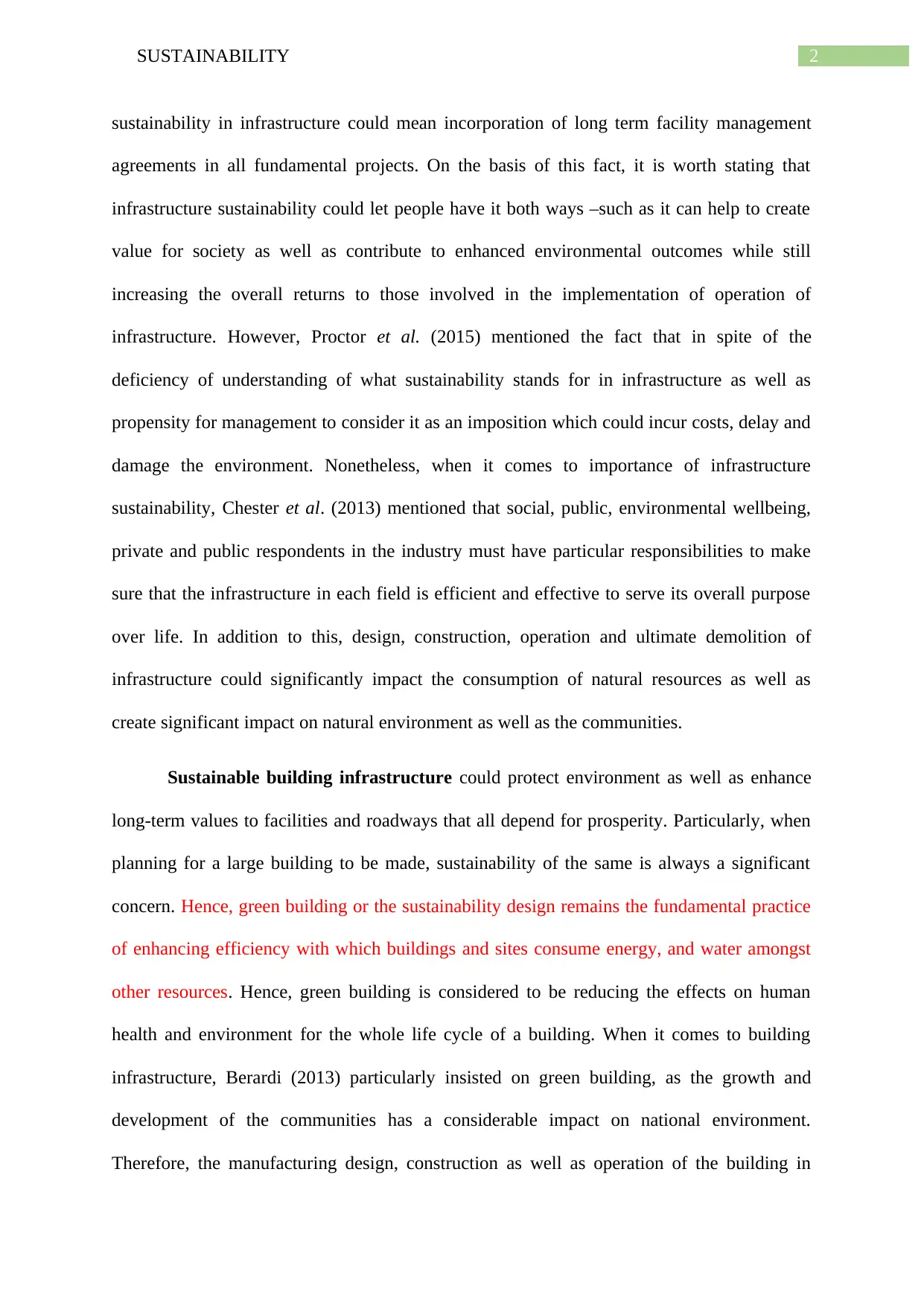
2SUSTAINABILITY
sustainability in infrastructure could mean incorporation of long term facility management
agreements in all fundamental projects. On the basis of this fact, it is worth stating that
infrastructure sustainability could let people have it both ways –such as it can help to create
value for society as well as contribute to enhanced environmental outcomes while still
increasing the overall returns to those involved in the implementation of operation of
infrastructure. However, Proctor et al. (2015) mentioned the fact that in spite of the
deficiency of understanding of what sustainability stands for in infrastructure as well as
propensity for management to consider it as an imposition which could incur costs, delay and
damage the environment. Nonetheless, when it comes to importance of infrastructure
sustainability, Chester et al. (2013) mentioned that social, public, environmental wellbeing,
private and public respondents in the industry must have particular responsibilities to make
sure that the infrastructure in each field is efficient and effective to serve its overall purpose
over life. In addition to this, design, construction, operation and ultimate demolition of
infrastructure could significantly impact the consumption of natural resources as well as
create significant impact on natural environment as well as the communities.
Sustainable building infrastructure could protect environment as well as enhance
long-term values to facilities and roadways that all depend for prosperity. Particularly, when
planning for a large building to be made, sustainability of the same is always a significant
concern. Hence, green building or the sustainability design remains the fundamental practice
of enhancing efficiency with which buildings and sites consume energy, and water amongst
other resources. Hence, green building is considered to be reducing the effects on human
health and environment for the whole life cycle of a building. When it comes to building
infrastructure, Berardi (2013) particularly insisted on green building, as the growth and
development of the communities has a considerable impact on national environment.
Therefore, the manufacturing design, construction as well as operation of the building in
sustainability in infrastructure could mean incorporation of long term facility management
agreements in all fundamental projects. On the basis of this fact, it is worth stating that
infrastructure sustainability could let people have it both ways –such as it can help to create
value for society as well as contribute to enhanced environmental outcomes while still
increasing the overall returns to those involved in the implementation of operation of
infrastructure. However, Proctor et al. (2015) mentioned the fact that in spite of the
deficiency of understanding of what sustainability stands for in infrastructure as well as
propensity for management to consider it as an imposition which could incur costs, delay and
damage the environment. Nonetheless, when it comes to importance of infrastructure
sustainability, Chester et al. (2013) mentioned that social, public, environmental wellbeing,
private and public respondents in the industry must have particular responsibilities to make
sure that the infrastructure in each field is efficient and effective to serve its overall purpose
over life. In addition to this, design, construction, operation and ultimate demolition of
infrastructure could significantly impact the consumption of natural resources as well as
create significant impact on natural environment as well as the communities.
Sustainable building infrastructure could protect environment as well as enhance
long-term values to facilities and roadways that all depend for prosperity. Particularly, when
planning for a large building to be made, sustainability of the same is always a significant
concern. Hence, green building or the sustainability design remains the fundamental practice
of enhancing efficiency with which buildings and sites consume energy, and water amongst
other resources. Hence, green building is considered to be reducing the effects on human
health and environment for the whole life cycle of a building. When it comes to building
infrastructure, Berardi (2013) particularly insisted on green building, as the growth and
development of the communities has a considerable impact on national environment.
Therefore, the manufacturing design, construction as well as operation of the building in
⊘ This is a preview!⊘
Do you want full access?
Subscribe today to unlock all pages.

Trusted by 1+ million students worldwide
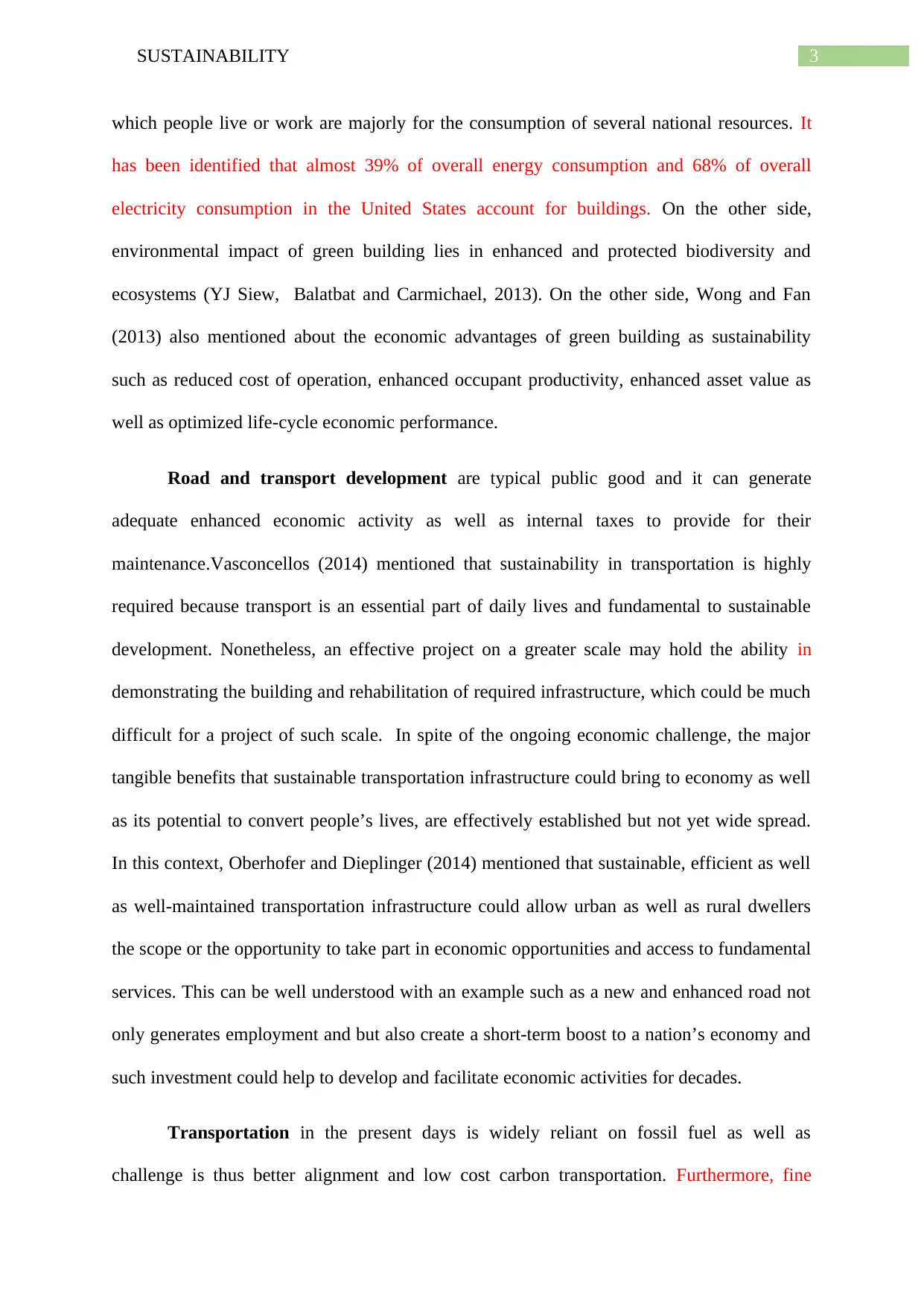
3SUSTAINABILITY
which people live or work are majorly for the consumption of several national resources. It
has been identified that almost 39% of overall energy consumption and 68% of overall
electricity consumption in the United States account for buildings. On the other side,
environmental impact of green building lies in enhanced and protected biodiversity and
ecosystems (YJ Siew, Balatbat and Carmichael, 2013). On the other side, Wong and Fan
(2013) also mentioned about the economic advantages of green building as sustainability
such as reduced cost of operation, enhanced occupant productivity, enhanced asset value as
well as optimized life-cycle economic performance.
Road and transport development are typical public good and it can generate
adequate enhanced economic activity as well as internal taxes to provide for their
maintenance.Vasconcellos (2014) mentioned that sustainability in transportation is highly
required because transport is an essential part of daily lives and fundamental to sustainable
development. Nonetheless, an effective project on a greater scale may hold the ability in
demonstrating the building and rehabilitation of required infrastructure, which could be much
difficult for a project of such scale. In spite of the ongoing economic challenge, the major
tangible benefits that sustainable transportation infrastructure could bring to economy as well
as its potential to convert people’s lives, are effectively established but not yet wide spread.
In this context, Oberhofer and Dieplinger (2014) mentioned that sustainable, efficient as well
as well-maintained transportation infrastructure could allow urban as well as rural dwellers
the scope or the opportunity to take part in economic opportunities and access to fundamental
services. This can be well understood with an example such as a new and enhanced road not
only generates employment and but also create a short-term boost to a nation’s economy and
such investment could help to develop and facilitate economic activities for decades.
Transportation in the present days is widely reliant on fossil fuel as well as
challenge is thus better alignment and low cost carbon transportation. Furthermore, fine
which people live or work are majorly for the consumption of several national resources. It
has been identified that almost 39% of overall energy consumption and 68% of overall
electricity consumption in the United States account for buildings. On the other side,
environmental impact of green building lies in enhanced and protected biodiversity and
ecosystems (YJ Siew, Balatbat and Carmichael, 2013). On the other side, Wong and Fan
(2013) also mentioned about the economic advantages of green building as sustainability
such as reduced cost of operation, enhanced occupant productivity, enhanced asset value as
well as optimized life-cycle economic performance.
Road and transport development are typical public good and it can generate
adequate enhanced economic activity as well as internal taxes to provide for their
maintenance.Vasconcellos (2014) mentioned that sustainability in transportation is highly
required because transport is an essential part of daily lives and fundamental to sustainable
development. Nonetheless, an effective project on a greater scale may hold the ability in
demonstrating the building and rehabilitation of required infrastructure, which could be much
difficult for a project of such scale. In spite of the ongoing economic challenge, the major
tangible benefits that sustainable transportation infrastructure could bring to economy as well
as its potential to convert people’s lives, are effectively established but not yet wide spread.
In this context, Oberhofer and Dieplinger (2014) mentioned that sustainable, efficient as well
as well-maintained transportation infrastructure could allow urban as well as rural dwellers
the scope or the opportunity to take part in economic opportunities and access to fundamental
services. This can be well understood with an example such as a new and enhanced road not
only generates employment and but also create a short-term boost to a nation’s economy and
such investment could help to develop and facilitate economic activities for decades.
Transportation in the present days is widely reliant on fossil fuel as well as
challenge is thus better alignment and low cost carbon transportation. Furthermore, fine
Paraphrase This Document
Need a fresh take? Get an instant paraphrase of this document with our AI Paraphraser

4SUSTAINABILITY
transportation with respect to enhancement of new sustainable development goals need to be
considered and such could deliver a significant transport system that fits the purpose and
provide large contribution to effective economic development. Apart from that, in the context
of transportation infrastructure, Arvidsson, Woxenius and Lammgård (2013) mentioned that
road safety is another significant concern as globally, 1.23 million people were killed in road
accidents crushes every year and up to 50 million seriously injured. It is particularly
identified that years of Action for Road Safety focuses on reducing road deaths as well as
injuries across the world as well as greater action is required globally to minimize these
appealing statistics. For example, Williams (2017) mentioned that UN Habitat Global Resort
on Human Settlement on sustainable mobility adopt the concept that mobility was not just
about developing transportation infrastructure and services but about the overcoming social,
economic as well as physical barriers to movement.
Energy infrastructure is another significant concern in sustainability because for
electricity grid, as a utility is highly responsible for maintaining the system. According to
Ahmad and Tahar (2014), if maintenance has breakdowns, solutions could consist of
enhancing overall utility management as well as cost recovery. This could also enhance the
penetration rate in the areas with the grid backbone but with a limited conditions. In this
context, Welschet al. (2014) commented that sustainability of energy is well understood as
the significant challenge that cover two major fields such as energy generation from the
renewable energy source as well as economic use of renewable and non-renewable sources.
The author of this study has mentioned about the major benefit of renewable energy sources
over non-renewable energy resource which is virtually unlimited for renewable resources.
transportation with respect to enhancement of new sustainable development goals need to be
considered and such could deliver a significant transport system that fits the purpose and
provide large contribution to effective economic development. Apart from that, in the context
of transportation infrastructure, Arvidsson, Woxenius and Lammgård (2013) mentioned that
road safety is another significant concern as globally, 1.23 million people were killed in road
accidents crushes every year and up to 50 million seriously injured. It is particularly
identified that years of Action for Road Safety focuses on reducing road deaths as well as
injuries across the world as well as greater action is required globally to minimize these
appealing statistics. For example, Williams (2017) mentioned that UN Habitat Global Resort
on Human Settlement on sustainable mobility adopt the concept that mobility was not just
about developing transportation infrastructure and services but about the overcoming social,
economic as well as physical barriers to movement.
Energy infrastructure is another significant concern in sustainability because for
electricity grid, as a utility is highly responsible for maintaining the system. According to
Ahmad and Tahar (2014), if maintenance has breakdowns, solutions could consist of
enhancing overall utility management as well as cost recovery. This could also enhance the
penetration rate in the areas with the grid backbone but with a limited conditions. In this
context, Welschet al. (2014) commented that sustainability of energy is well understood as
the significant challenge that cover two major fields such as energy generation from the
renewable energy source as well as economic use of renewable and non-renewable sources.
The author of this study has mentioned about the major benefit of renewable energy sources
over non-renewable energy resource which is virtually unlimited for renewable resources.
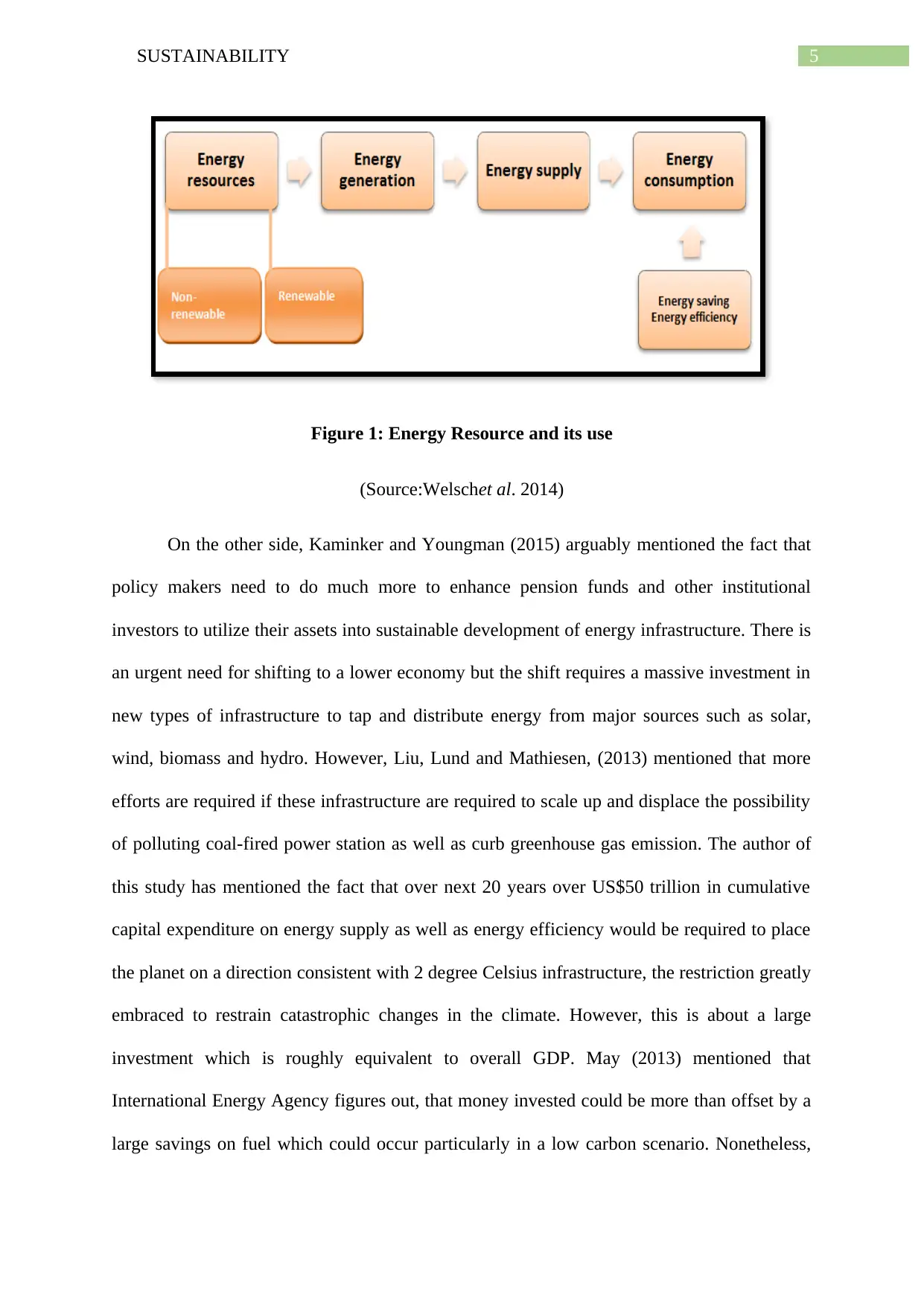
5SUSTAINABILITY
Figure 1: Energy Resource and its use
(Source:Welschet al. 2014)
On the other side, Kaminker and Youngman (2015) arguably mentioned the fact that
policy makers need to do much more to enhance pension funds and other institutional
investors to utilize their assets into sustainable development of energy infrastructure. There is
an urgent need for shifting to a lower economy but the shift requires a massive investment in
new types of infrastructure to tap and distribute energy from major sources such as solar,
wind, biomass and hydro. However, Liu, Lund and Mathiesen, (2013) mentioned that more
efforts are required if these infrastructure are required to scale up and displace the possibility
of polluting coal-fired power station as well as curb greenhouse gas emission. The author of
this study has mentioned the fact that over next 20 years over US$50 trillion in cumulative
capital expenditure on energy supply as well as energy efficiency would be required to place
the planet on a direction consistent with 2 degree Celsius infrastructure, the restriction greatly
embraced to restrain catastrophic changes in the climate. However, this is about a large
investment which is roughly equivalent to overall GDP. May (2013) mentioned that
International Energy Agency figures out, that money invested could be more than offset by a
large savings on fuel which could occur particularly in a low carbon scenario. Nonetheless,
Figure 1: Energy Resource and its use
(Source:Welschet al. 2014)
On the other side, Kaminker and Youngman (2015) arguably mentioned the fact that
policy makers need to do much more to enhance pension funds and other institutional
investors to utilize their assets into sustainable development of energy infrastructure. There is
an urgent need for shifting to a lower economy but the shift requires a massive investment in
new types of infrastructure to tap and distribute energy from major sources such as solar,
wind, biomass and hydro. However, Liu, Lund and Mathiesen, (2013) mentioned that more
efforts are required if these infrastructure are required to scale up and displace the possibility
of polluting coal-fired power station as well as curb greenhouse gas emission. The author of
this study has mentioned the fact that over next 20 years over US$50 trillion in cumulative
capital expenditure on energy supply as well as energy efficiency would be required to place
the planet on a direction consistent with 2 degree Celsius infrastructure, the restriction greatly
embraced to restrain catastrophic changes in the climate. However, this is about a large
investment which is roughly equivalent to overall GDP. May (2013) mentioned that
International Energy Agency figures out, that money invested could be more than offset by a
large savings on fuel which could occur particularly in a low carbon scenario. Nonetheless,
⊘ This is a preview!⊘
Do you want full access?
Subscribe today to unlock all pages.

Trusted by 1+ million students worldwide
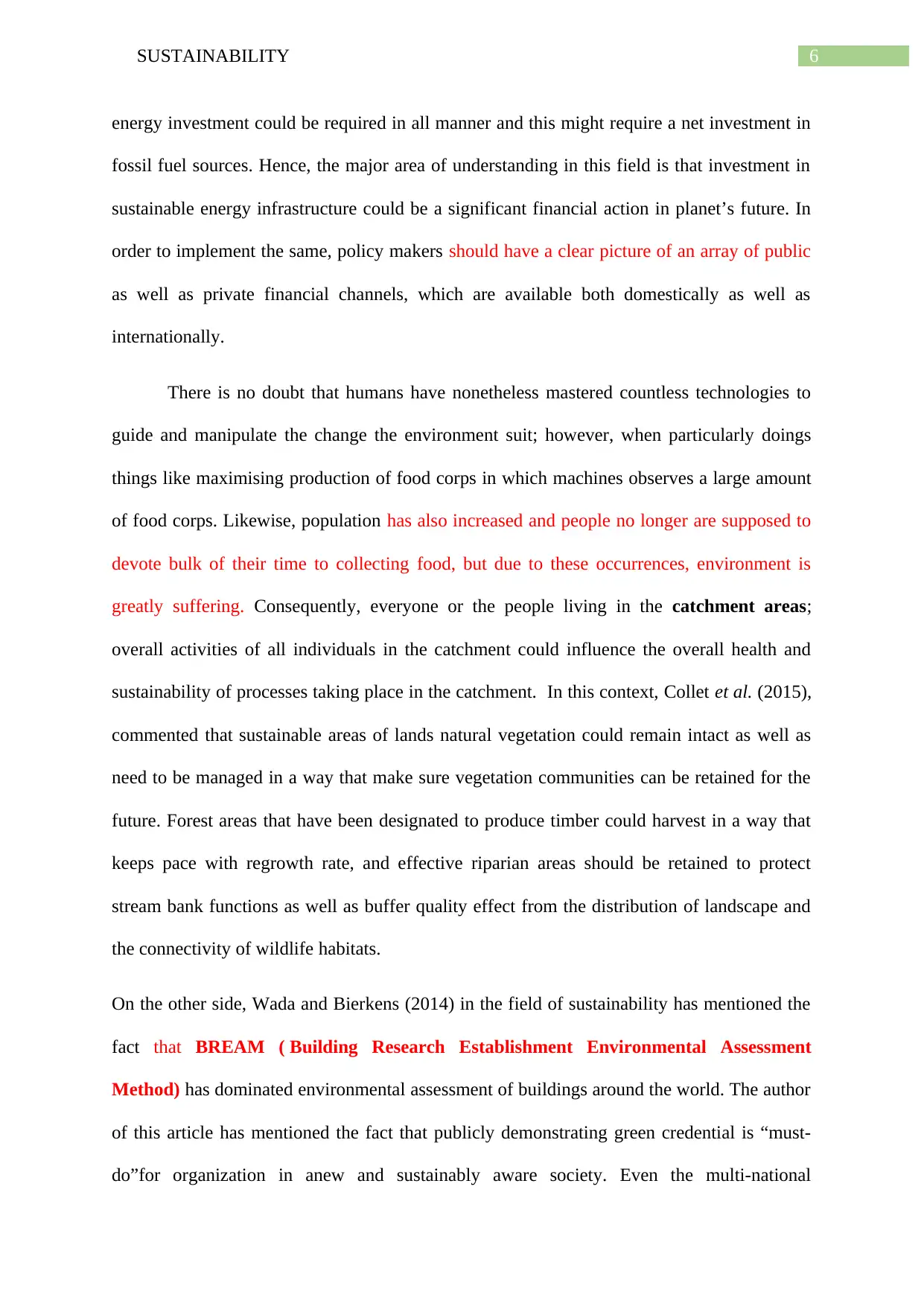
6SUSTAINABILITY
energy investment could be required in all manner and this might require a net investment in
fossil fuel sources. Hence, the major area of understanding in this field is that investment in
sustainable energy infrastructure could be a significant financial action in planet’s future. In
order to implement the same, policy makers should have a clear picture of an array of public
as well as private financial channels, which are available both domestically as well as
internationally.
There is no doubt that humans have nonetheless mastered countless technologies to
guide and manipulate the change the environment suit; however, when particularly doings
things like maximising production of food corps in which machines observes a large amount
of food corps. Likewise, population has also increased and people no longer are supposed to
devote bulk of their time to collecting food, but due to these occurrences, environment is
greatly suffering. Consequently, everyone or the people living in the catchment areas;
overall activities of all individuals in the catchment could influence the overall health and
sustainability of processes taking place in the catchment. In this context, Collet et al. (2015),
commented that sustainable areas of lands natural vegetation could remain intact as well as
need to be managed in a way that make sure vegetation communities can be retained for the
future. Forest areas that have been designated to produce timber could harvest in a way that
keeps pace with regrowth rate, and effective riparian areas should be retained to protect
stream bank functions as well as buffer quality effect from the distribution of landscape and
the connectivity of wildlife habitats.
On the other side, Wada and Bierkens (2014) in the field of sustainability has mentioned the
fact that BREAM ( Building Research Establishment Environmental Assessment
Method) has dominated environmental assessment of buildings around the world. The author
of this article has mentioned the fact that publicly demonstrating green credential is “must-
do”for organization in anew and sustainably aware society. Even the multi-national
energy investment could be required in all manner and this might require a net investment in
fossil fuel sources. Hence, the major area of understanding in this field is that investment in
sustainable energy infrastructure could be a significant financial action in planet’s future. In
order to implement the same, policy makers should have a clear picture of an array of public
as well as private financial channels, which are available both domestically as well as
internationally.
There is no doubt that humans have nonetheless mastered countless technologies to
guide and manipulate the change the environment suit; however, when particularly doings
things like maximising production of food corps in which machines observes a large amount
of food corps. Likewise, population has also increased and people no longer are supposed to
devote bulk of their time to collecting food, but due to these occurrences, environment is
greatly suffering. Consequently, everyone or the people living in the catchment areas;
overall activities of all individuals in the catchment could influence the overall health and
sustainability of processes taking place in the catchment. In this context, Collet et al. (2015),
commented that sustainable areas of lands natural vegetation could remain intact as well as
need to be managed in a way that make sure vegetation communities can be retained for the
future. Forest areas that have been designated to produce timber could harvest in a way that
keeps pace with regrowth rate, and effective riparian areas should be retained to protect
stream bank functions as well as buffer quality effect from the distribution of landscape and
the connectivity of wildlife habitats.
On the other side, Wada and Bierkens (2014) in the field of sustainability has mentioned the
fact that BREAM ( Building Research Establishment Environmental Assessment
Method) has dominated environmental assessment of buildings around the world. The author
of this article has mentioned the fact that publicly demonstrating green credential is “must-
do”for organization in anew and sustainably aware society. Even the multi-national
Paraphrase This Document
Need a fresh take? Get an instant paraphrase of this document with our AI Paraphraser
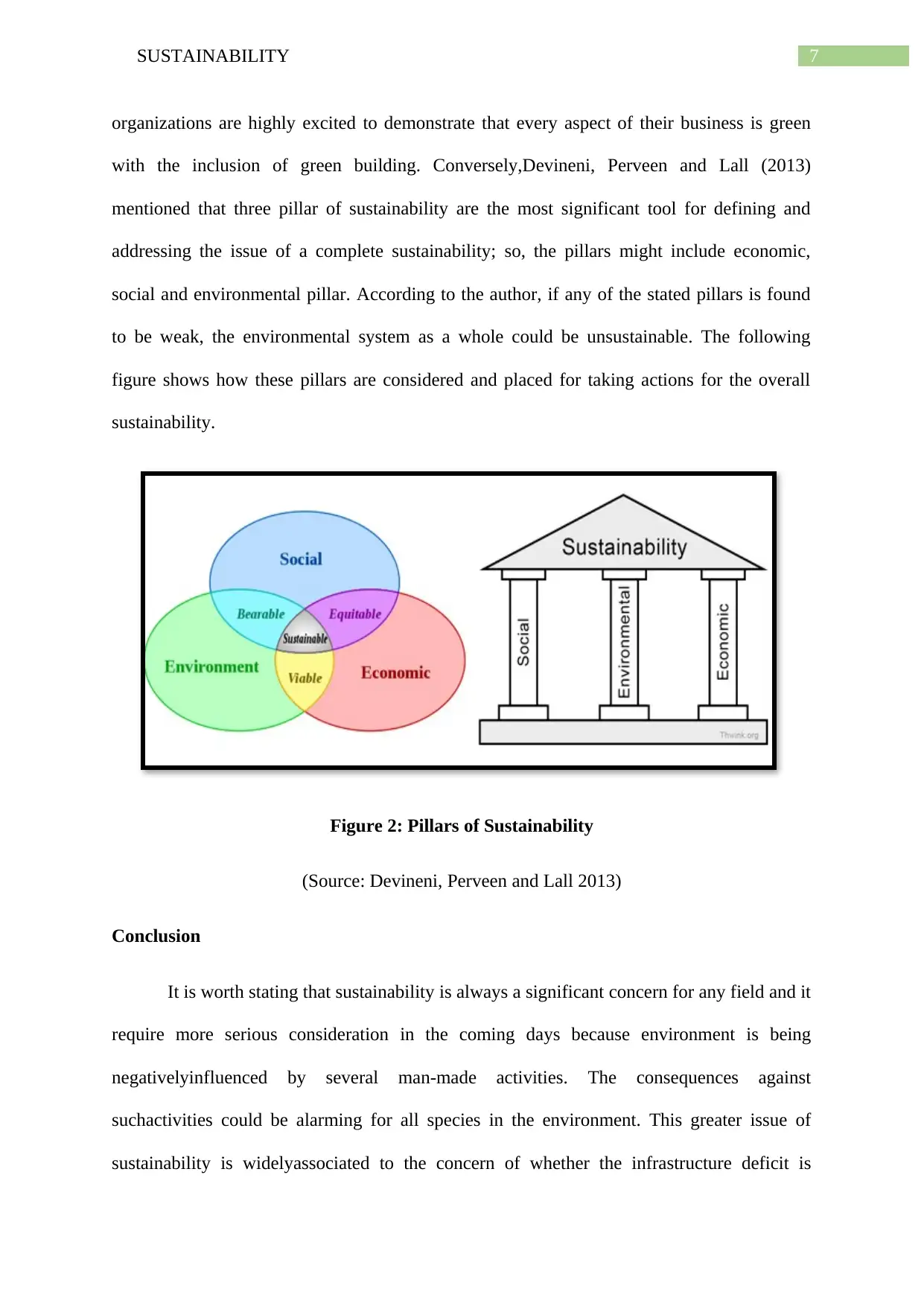
7SUSTAINABILITY
organizations are highly excited to demonstrate that every aspect of their business is green
with the inclusion of green building. Conversely,Devineni, Perveen and Lall (2013)
mentioned that three pillar of sustainability are the most significant tool for defining and
addressing the issue of a complete sustainability; so, the pillars might include economic,
social and environmental pillar. According to the author, if any of the stated pillars is found
to be weak, the environmental system as a whole could be unsustainable. The following
figure shows how these pillars are considered and placed for taking actions for the overall
sustainability.
Figure 2: Pillars of Sustainability
(Source: Devineni, Perveen and Lall 2013)
Conclusion
It is worth stating that sustainability is always a significant concern for any field and it
require more serious consideration in the coming days because environment is being
negativelyinfluenced by several man-made activities. The consequences against
suchactivities could be alarming for all species in the environment. This greater issue of
sustainability is widelyassociated to the concern of whether the infrastructure deficit is
organizations are highly excited to demonstrate that every aspect of their business is green
with the inclusion of green building. Conversely,Devineni, Perveen and Lall (2013)
mentioned that three pillar of sustainability are the most significant tool for defining and
addressing the issue of a complete sustainability; so, the pillars might include economic,
social and environmental pillar. According to the author, if any of the stated pillars is found
to be weak, the environmental system as a whole could be unsustainable. The following
figure shows how these pillars are considered and placed for taking actions for the overall
sustainability.
Figure 2: Pillars of Sustainability
(Source: Devineni, Perveen and Lall 2013)
Conclusion
It is worth stating that sustainability is always a significant concern for any field and it
require more serious consideration in the coming days because environment is being
negativelyinfluenced by several man-made activities. The consequences against
suchactivities could be alarming for all species in the environment. This greater issue of
sustainability is widelyassociated to the concern of whether the infrastructure deficit is

8SUSTAINABILITY
addressed at all. All businesses should note the fact that maintenance is not an exercise that
occurs by accident, it is rather a part and parcel of infrastructuredevelopment. Thus, the
resources should be available particularly for the maintenance if they have to continue their
functions.
addressed at all. All businesses should note the fact that maintenance is not an exercise that
occurs by accident, it is rather a part and parcel of infrastructuredevelopment. Thus, the
resources should be available particularly for the maintenance if they have to continue their
functions.
⊘ This is a preview!⊘
Do you want full access?
Subscribe today to unlock all pages.

Trusted by 1+ million students worldwide
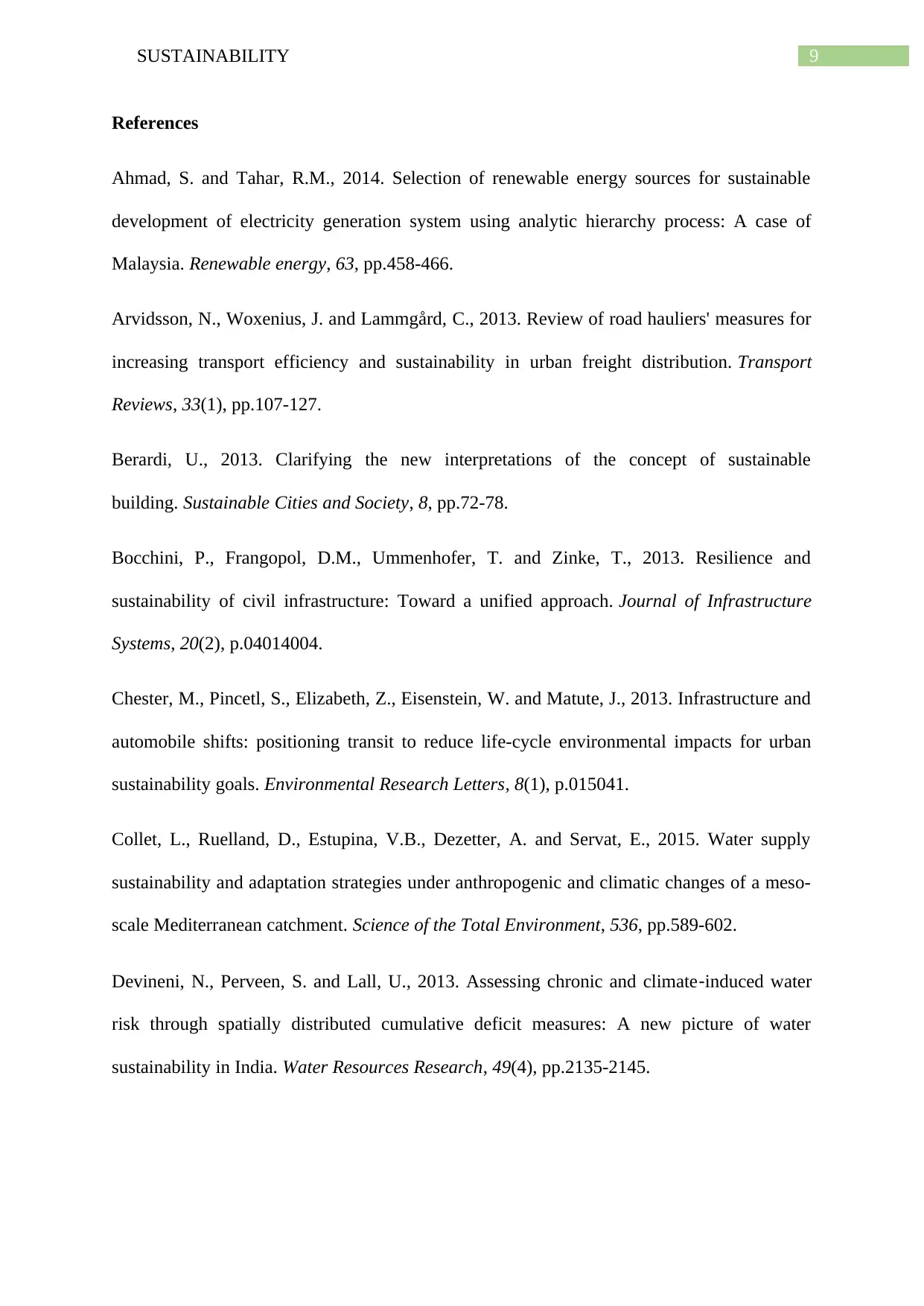
9SUSTAINABILITY
References
Ahmad, S. and Tahar, R.M., 2014. Selection of renewable energy sources for sustainable
development of electricity generation system using analytic hierarchy process: A case of
Malaysia. Renewable energy, 63, pp.458-466.
Arvidsson, N., Woxenius, J. and Lammgård, C., 2013. Review of road hauliers' measures for
increasing transport efficiency and sustainability in urban freight distribution. Transport
Reviews, 33(1), pp.107-127.
Berardi, U., 2013. Clarifying the new interpretations of the concept of sustainable
building. Sustainable Cities and Society, 8, pp.72-78.
Bocchini, P., Frangopol, D.M., Ummenhofer, T. and Zinke, T., 2013. Resilience and
sustainability of civil infrastructure: Toward a unified approach. Journal of Infrastructure
Systems, 20(2), p.04014004.
Chester, M., Pincetl, S., Elizabeth, Z., Eisenstein, W. and Matute, J., 2013. Infrastructure and
automobile shifts: positioning transit to reduce life-cycle environmental impacts for urban
sustainability goals. Environmental Research Letters, 8(1), p.015041.
Collet, L., Ruelland, D., Estupina, V.B., Dezetter, A. and Servat, E., 2015. Water supply
sustainability and adaptation strategies under anthropogenic and climatic changes of a meso-
scale Mediterranean catchment. Science of the Total Environment, 536, pp.589-602.
Devineni, N., Perveen, S. and Lall, U., 2013. Assessing chronic and climate‐induced water
risk through spatially distributed cumulative deficit measures: A new picture of water
sustainability in India. Water Resources Research, 49(4), pp.2135-2145.
References
Ahmad, S. and Tahar, R.M., 2014. Selection of renewable energy sources for sustainable
development of electricity generation system using analytic hierarchy process: A case of
Malaysia. Renewable energy, 63, pp.458-466.
Arvidsson, N., Woxenius, J. and Lammgård, C., 2013. Review of road hauliers' measures for
increasing transport efficiency and sustainability in urban freight distribution. Transport
Reviews, 33(1), pp.107-127.
Berardi, U., 2013. Clarifying the new interpretations of the concept of sustainable
building. Sustainable Cities and Society, 8, pp.72-78.
Bocchini, P., Frangopol, D.M., Ummenhofer, T. and Zinke, T., 2013. Resilience and
sustainability of civil infrastructure: Toward a unified approach. Journal of Infrastructure
Systems, 20(2), p.04014004.
Chester, M., Pincetl, S., Elizabeth, Z., Eisenstein, W. and Matute, J., 2013. Infrastructure and
automobile shifts: positioning transit to reduce life-cycle environmental impacts for urban
sustainability goals. Environmental Research Letters, 8(1), p.015041.
Collet, L., Ruelland, D., Estupina, V.B., Dezetter, A. and Servat, E., 2015. Water supply
sustainability and adaptation strategies under anthropogenic and climatic changes of a meso-
scale Mediterranean catchment. Science of the Total Environment, 536, pp.589-602.
Devineni, N., Perveen, S. and Lall, U., 2013. Assessing chronic and climate‐induced water
risk through spatially distributed cumulative deficit measures: A new picture of water
sustainability in India. Water Resources Research, 49(4), pp.2135-2145.
Paraphrase This Document
Need a fresh take? Get an instant paraphrase of this document with our AI Paraphraser

10SUSTAINABILITY
Kaminker, C. and Youngman, R., 2015. Sustainable energy infrastructure, finance and
institutional investors. Organisation for Economic Cooperation and Development. The
OECD Observer, (304), p.20.
Liu, W., Lund, H. and Mathiesen, B.V., 2013. Modelling the transport system in China and
evaluating the current strategies towards the sustainable transport development. Energy
Policy, 58, pp.347-357.
May, A.D., 2013. Urban transport and sustainability: The key challenges. International
journal of sustainable transportation, 7(3), pp.170-185.
Oberhofer, P. and Dieplinger, M., 2014. Sustainability in the transport and logistics sector:
lacking environmental measures. Business Strategy and the Environment, 23(4), pp.236-253.
Proctor, E., Luke, D., Calhoun, A., McMillen, C., Brownson, R., McCrary, S., and Padek, M.
2015. Sustainability of evidence-based healthcare: research agenda, methodological
advances, and infrastructure support. Implementation Science, 10(1), 88.
Vasconcellos, E.A., 2014. Urban Transport Environment and Equity: The case for
developing countries. Routledge.
Wada, Y. and Bierkens, M.F., 2014. Sustainability of global water use: past reconstruction
and future projections. Environmental Research Letters, 9(10), p.104003.
Weber, B., Alfen, H. W., & Staub-Bisang, M. (2016). Infrastructure as an asset class:
investment strategy, sustainability, project finance and PPP. John wiley& sons.
Welsch, M., Deane, P., Howells, M., Gallachóir, B.Ó., Rogan, F., Bazilian, M. and Rogner,
H.H., 2014. Incorporating flexibility requirements into long-term energy system models–A
case study on high levels of renewable electricity penetration in Ireland. Applied Energy, 135,
pp.600-615.
Kaminker, C. and Youngman, R., 2015. Sustainable energy infrastructure, finance and
institutional investors. Organisation for Economic Cooperation and Development. The
OECD Observer, (304), p.20.
Liu, W., Lund, H. and Mathiesen, B.V., 2013. Modelling the transport system in China and
evaluating the current strategies towards the sustainable transport development. Energy
Policy, 58, pp.347-357.
May, A.D., 2013. Urban transport and sustainability: The key challenges. International
journal of sustainable transportation, 7(3), pp.170-185.
Oberhofer, P. and Dieplinger, M., 2014. Sustainability in the transport and logistics sector:
lacking environmental measures. Business Strategy and the Environment, 23(4), pp.236-253.
Proctor, E., Luke, D., Calhoun, A., McMillen, C., Brownson, R., McCrary, S., and Padek, M.
2015. Sustainability of evidence-based healthcare: research agenda, methodological
advances, and infrastructure support. Implementation Science, 10(1), 88.
Vasconcellos, E.A., 2014. Urban Transport Environment and Equity: The case for
developing countries. Routledge.
Wada, Y. and Bierkens, M.F., 2014. Sustainability of global water use: past reconstruction
and future projections. Environmental Research Letters, 9(10), p.104003.
Weber, B., Alfen, H. W., & Staub-Bisang, M. (2016). Infrastructure as an asset class:
investment strategy, sustainability, project finance and PPP. John wiley& sons.
Welsch, M., Deane, P., Howells, M., Gallachóir, B.Ó., Rogan, F., Bazilian, M. and Rogner,
H.H., 2014. Incorporating flexibility requirements into long-term energy system models–A
case study on high levels of renewable electricity penetration in Ireland. Applied Energy, 135,
pp.600-615.
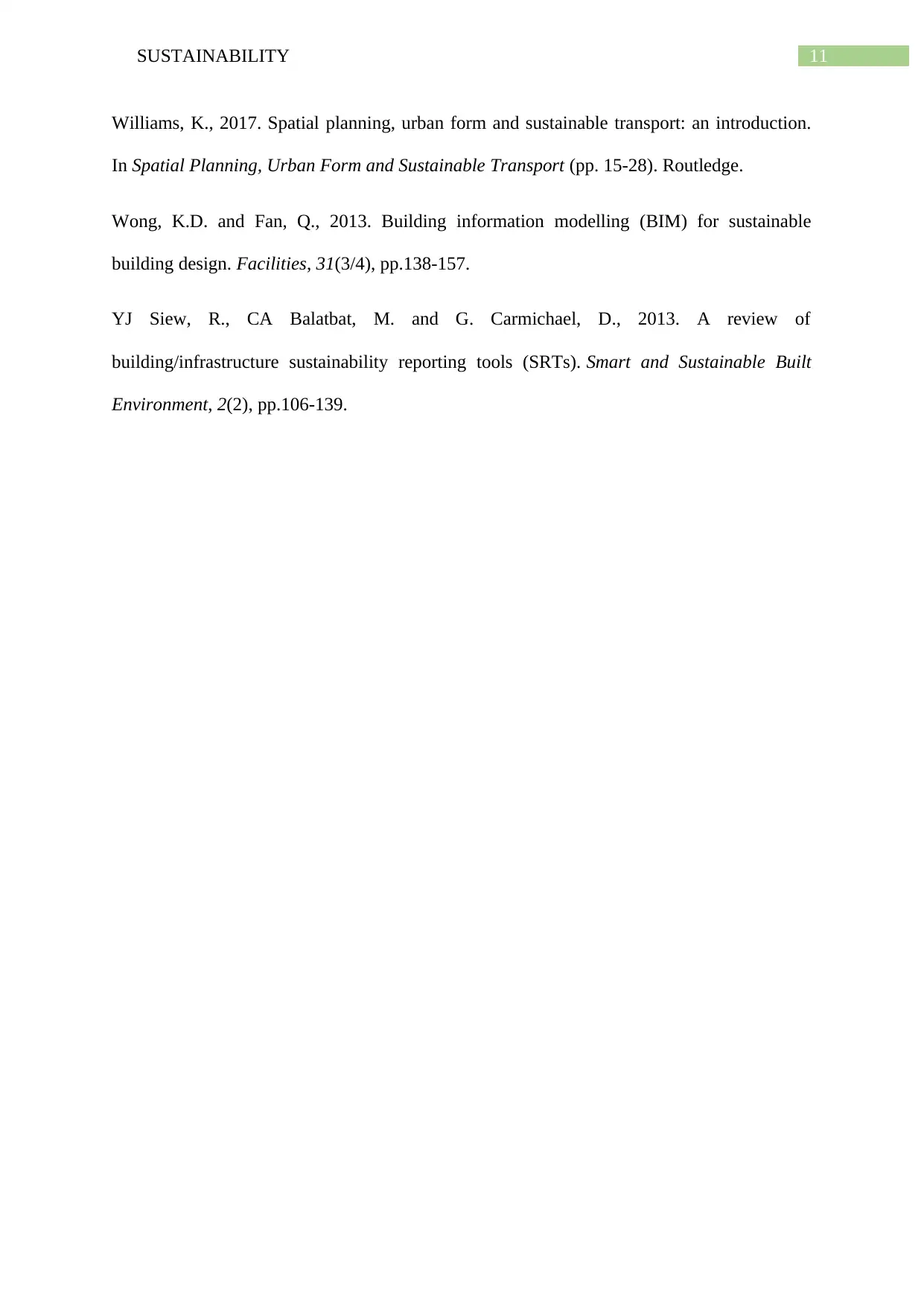
11SUSTAINABILITY
Williams, K., 2017. Spatial planning, urban form and sustainable transport: an introduction.
In Spatial Planning, Urban Form and Sustainable Transport (pp. 15-28). Routledge.
Wong, K.D. and Fan, Q., 2013. Building information modelling (BIM) for sustainable
building design. Facilities, 31(3/4), pp.138-157.
YJ Siew, R., CA Balatbat, M. and G. Carmichael, D., 2013. A review of
building/infrastructure sustainability reporting tools (SRTs). Smart and Sustainable Built
Environment, 2(2), pp.106-139.
Williams, K., 2017. Spatial planning, urban form and sustainable transport: an introduction.
In Spatial Planning, Urban Form and Sustainable Transport (pp. 15-28). Routledge.
Wong, K.D. and Fan, Q., 2013. Building information modelling (BIM) for sustainable
building design. Facilities, 31(3/4), pp.138-157.
YJ Siew, R., CA Balatbat, M. and G. Carmichael, D., 2013. A review of
building/infrastructure sustainability reporting tools (SRTs). Smart and Sustainable Built
Environment, 2(2), pp.106-139.
⊘ This is a preview!⊘
Do you want full access?
Subscribe today to unlock all pages.

Trusted by 1+ million students worldwide
1 out of 12
Related Documents
Your All-in-One AI-Powered Toolkit for Academic Success.
+13062052269
info@desklib.com
Available 24*7 on WhatsApp / Email
![[object Object]](/_next/static/media/star-bottom.7253800d.svg)
Unlock your academic potential
Copyright © 2020–2025 A2Z Services. All Rights Reserved. Developed and managed by ZUCOL.





